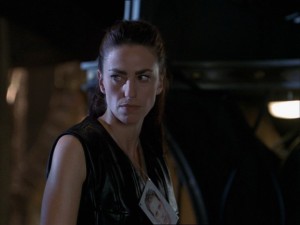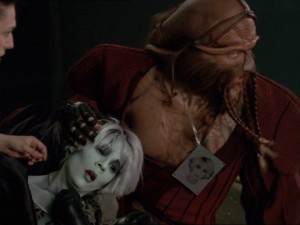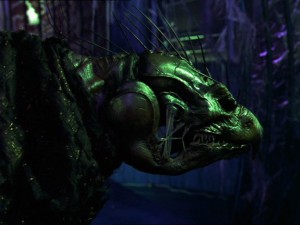Season 2, Episode 9 — Out of Their Minds
You’ve seen it before: it’s the body-switching episode. The episode where the characters get to act like someone they’re not, the episode one assumes was more fun to make than it is to watch. It’s difficult to recall a science fiction show of Farscape’s era that doesn’t have an episode like this (one that lets characters act differently than they usually do — think Star Trek’s “Mirror, Mirror” or Stargate SG-1’s “Holiday” or any episodes where all the characters get mysteriously inebriated), but Farscape manages to twist the cliché around on itself. While the characters in the episode are so fixated on their physical appearance — on their bodies — we as viewers are invited to step back and reexamine the role that those bodies — that all bodies — play in the construction of societal norms and practices.
A hastily-explained interaction between an enemy ship’s energy weapon and the shoddy defense screen bootlegged from the Zelbinion way back in the last season causes the crew, in groups of three, to swap bodies with one another. Naturally this results in a lot of confusion and a lot of opportunities for body-part-related gags such as Rygel-in-Crichton’s attempt to urinate and Crichton-in-Aeryn’s boob shaking (and more — “oh momma!”). By the end of the episode everyone is so mixed up and/or intoxicated by the experience of being “inside” each others’ bodies that several of them pair off to presumably have sex. Bodies rule the day.
Different bodies can do different things. Some of those things are obvious — D’Argo is strong, Rygel is small — but some are less recognizable without a new perspective. Pilot’s constant interaction with the countless number of Moya’s systems, for example, has until now been portrayed as a sort of talent. It’s his job, it’s what he does. But in this episode it’s shown to also be a feature unique to his physiology. He’s able to do what he does because of the way his body works (presumably his brain, mostly), and so D’Argo can do it too while he’s in Pilot’s body. The rest of the crew also discover things about each other’s bodies through the course of their switchings.
John deals with the experience of being in someone else’s body better than most everyone else, or at least he adapts more quickly. John’s usual chipper and problem-solving self is maintained throughout his trip through the bodies of Aeryn and Rygel. In keeping with his exploratory nature, the experience of being in another body is almost an adventure to John. By this point he’s used to the wackiness that can occur in the Uncharted Territories and he’s usually willing to go along for the ride. John’s travels through the other bodies he inhabits suggest that identity is something separate from the body. He may take various opportunities to “explore” Aeryn’s female morphology but he still considers himself innately him, he’s still Crichton.
Chiana adapts, too, but in a different way. Mouth constantly agape, Chiana-in-D’Argo is not particularly concerned with the fact that she might be stuck in a different body for the rest of her life. She attempts to seduce Rygel-in-John and convince him to flee with her. This is perhaps mostly a sort of fan-fiction indulgence but the scene also briefly explores the fluidity of gender. Chiana sees bodies as tools, so if she has a different one now that’s better than not having one at all.
Chiana also feels no compulsion to perform masculinity in the same way the others attempt to perform the behaviors of the bodies they’re in when the Halosian visits Moya (although it’s fairly unclear why they would need to bother pretending to be the bodies they’re in since the Halosian hasn’t met them before and probably doesn’t care). Chiana-in-D’Argo is not exactly feminine or masculine, s/he behaves as both. Despite the brevity of the scenes where actual character development might take place, Chiana-in-D’Argo is a unique study in the ways that gender is built up not from physical appearance but from action and interaction. Chiana is certainly willing to bend the rules.
Unlike Chiana, Rygel is single-mindedly focused on his body. Throughout the entire episode his only concern is getting his “body back.” Rygel sees a strong connection between the body and identity, even going so far as to in some ways still consider his now dissociated body as a part of him. He quips that his “own body shouldn’t be suspicious” of him, and seems to see his ability to function as an individual diminished because of his separation from his corporeal form. He denigrates the “gangly hunk of flesh” he finds himself in, just as John and Aeryn do to the Hynerian body they take turns inhabiting. While his body’s diminutive size and lack of humanoid range of motion are seen as flaws to the others (Aeryn says of Rygel’s arms, “I can’t do anything with these”), he sees the same disparity in being forced to live as something different. Part of his distress, he reveals, has to do with the fact that his goal to reclaim his usurped throne can only be achieved if he is actually a Hynerian. But he also betrays a strong affinity with what he considers to be a “normal” body.
This is not to say that the rest of the crew do not also want their bodies back. But Rygel more than any of the rest of them (closely followed maybe by Pilot, who is barely able to stay conscious when switched with the others) sees his misplacement in a new body as a nearly life-ending event. He can no longer be what he wants to be, he is no longer able to fully realize his desired existence. Nothing short of returning to his original form will alleviate his distress.
As an extension of the body-swapping nonsense taking place on Moya, the episode’s villains are strangely fixated on the corporeal. The Halosian concept of “evolution” requires the constant conquest of hostile lifeforms. On board Moya we witness a spectrum of attitudes concerning how bodies work and how they should be used. On the Halosian ship bodies serve only one purpose: they are conquered and plundered. The physical appearance of the Halosians reinforces their scavenging behavior — they’re obviously supposed to look like vultures, and their flesh seems barely held together by strands of sinew.
The callously utilitarian attitude with which the Halosians treat life is a symbolic indictment of some of the essentialist perspectives we see on Moya. The Halosian way of life is so obviously unappealing and morally objectionable (from our perspective as viewers, anyway) that it serves a cautionary role in the episode, warning against any feeling of identification with one of the main characters’ reactions to their plight. John’s “the body I’m in doesn’t matter because I’m still me” or Rygel’s “I’m not me without my body” both lead down a road toward the Halosian philosophy because they both ignore essential characteristics of bodies.
We exist neither just as bodies or as something other than bodies. Identity doesn’t mean anything (or, at any rate, it doesn’t mean what we usually mean by it) without the body. This does not mean that the characters on Moya must embrace, as Chiana does, their newfound existence as if it were as vital to them as their original one. But it does mean that the episode moves away from supporting a view of the body as isolated from the actions and thoughts of the person inhabiting it. After the experience everyone has a newfound appreciation for what makes them them — not just their bodies or their minds in isolation but the combination of the two.





